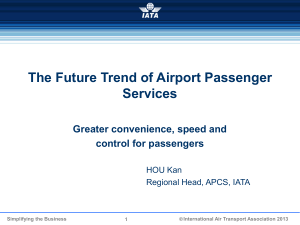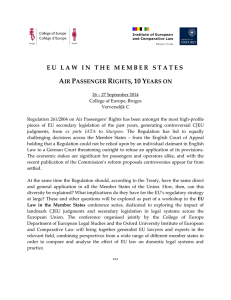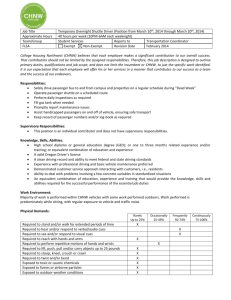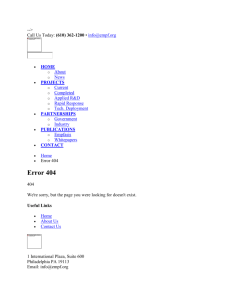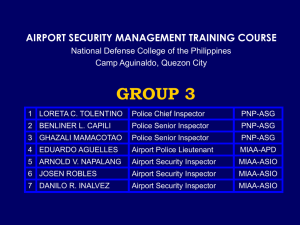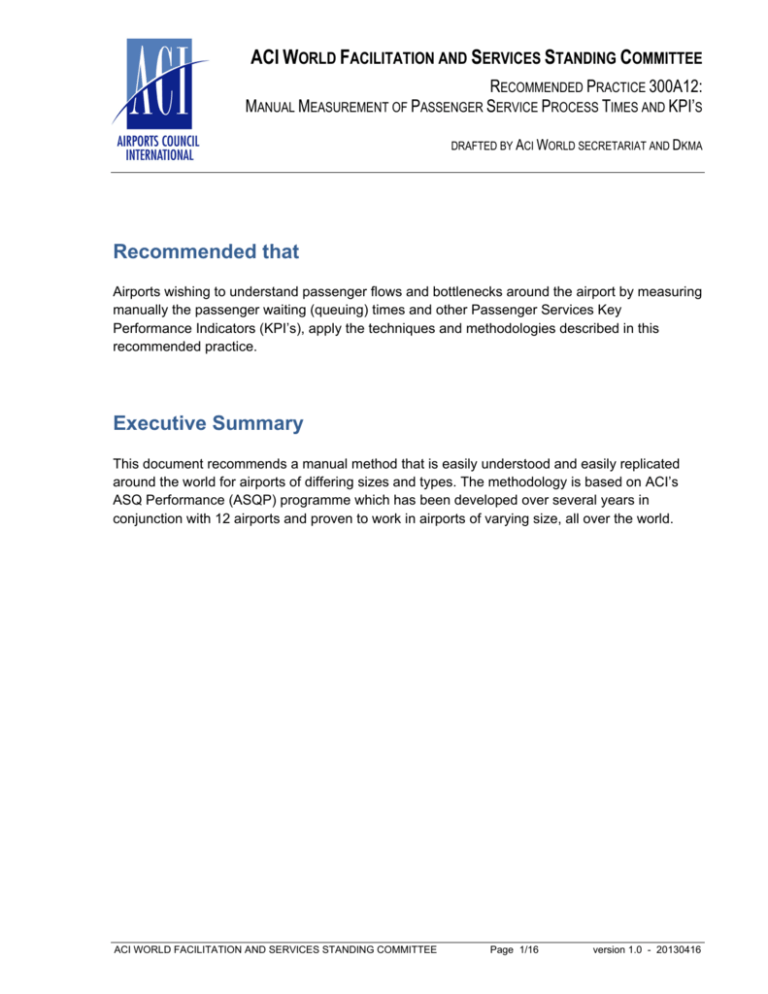
ACI WORLD FACILITATION AND SERVICES STANDING COMMITTEE
RECOMMENDED PRACTICE 300A12:
MANUAL MEASUREMENT OF PASSENGER SERVICE PROCESS TIMES AND KPI’S
DRAFTED BY ACI WORLD SECRETARIAT AND DKMA
Recommended that
Airports wishing to understand passenger flows and bottlenecks around the airport by measuring
manually the passenger waiting (queuing) times and other Passenger Services Key
Performance Indicators (KPI’s), apply the techniques and methodologies described in this
recommended practice.
Executive Summary
This document recommends a manual method that is easily understood and easily replicated
around the world for airports of differing sizes and types. The methodology is based on ACI’s
ASQ Performance (ASQP) programme which has been developed over several years in
conjunction with 12 airports and proven to work in airports of varying size, all over the world.
ACI WORLD FACILITATION AND SERVICES STANDING COMMITTEE
Page 1/16
version 1.0 - 20130416
ACI WORLD – RECOMMENDED PRACTICE 300A12:
MANUAL MEASUREMENT OF PASSENGER SERVICE PROCESS TIMES AND KPI’S
Table of Contents
Recommended that.......................................................................................................... 1
Executive Summary ......................................................................................................... 1
1.
Introduction................................................................................................................ 3
1.1. Long term goals .................................................................................................. 3
1.2. Usage of the data ............................................................................................... 4
2.
Key Performance Indicators (KPIs) ........................................................................... 5
3.
Methodology .............................................................................................................. 6
3.1. When to measure ............................................................................................... 6
3.2. Where to measure .............................................................................................. 7
3.3. How to measure .................................................................................................. 7
3.4. Sample sizes ...................................................................................................... 8
3.5. Measuring queue times....................................................................................... 9
3.5.1.
Disney queues (one queue serving multiple counters/checkpoints) ................ 9
3.5.2.
Single queues (one queue serves one counter/checkpoint) .......................... 10
3.6. Recommended practice for different areas of the airport .................................. 11
4.
3.6.1.
Check-in ........................................................................................................ 11
3.6.2.
Passport control............................................................................................. 12
3.6.3.
Security control .............................................................................................. 12
3.6.4.
Transfer counters .......................................................................................... 12
3.6.5.
Boarding ........................................................................................................ 12
3.6.6.
Baggage delivery ........................................................................................... 13
3.6.7.
Customs inspection ....................................................................................... 13
3.6.8.
Baggage Carts............................................................................................... 13
Acknowledgements ................................................................................................. 14
Appendix 1: References................................................................................................. 15
Appendix 2: Passenger Counting Technologies ............................................................ 16
ACI WORLD FACILITATION AND SERVICES STANDING COMMITTEE
Page 2/16
version 1.0 - 20130416
ACI WORLD – RECOMMENDED PRACTICE 300A12:
MANUAL MEASUREMENT OF PASSENGER SERVICE PROCESS TIMES AND KPI’S
1. Introduction
There are many ways of measuring passenger process times. This document recommends a
manual method that is easily understood and easily replicated around the world for airports of
differing sizes and types. The methodology is based on ACI’s ASQ Performance (ASQP)
programme which has been developed over several years in conjunction with 12 airports and
proven to work in airports of varying size, all over the world from Europe to Africa to the Middle
East.
ASQP was designed specifically to measure delivered service quality levels and the central
concept has been to ensure accuracy and comparability of results. This comparability allows
airports and the airport industry to work together to create benchmarks and identify true best
practice.
ASQP is part of ACI’s global Airport Service Quality initiative and is fully compatible with the
passenger satisfaction benchmark ASQ Survey – currently used by over 275 airports worldwide
– the ASQ Assured airport certification, and the ASQ Retail programme.
Figure 1: ACI Airport Service Quality (ASQ) programmes
1.1.
Long term goals
Create real world standards for passenger facilitation at airports of all sizes and types
around the world.
Identification of best practice
Complement the passenger’s “subjective quality” assessment by measuring the actual
“objective quality” of service delivered
Improve the passenger experience
ACI WORLD FACILITATION AND SERVICES STANDING COMMITTEE
Page 3/16
version 1.0 - 20130416
ACI WORLD – RECOMMENDED PRACTICE 300A12:
MANUAL MEASUREMENT OF PASSENGER SERVICE PROCESS TIMES AND KPI’S
1.2.
Usage of the data
This document makes no recommendations on how Passenger Process time data should be
used. However, it is noted that Key Performance Indicator (KPI) measurements are already
being used in a variety of ways such as:
1. monitoring and incentivising teams;
2. as an input into the overall quality management process;
3. as a target or threshold in Service Level Agreements (SLA);
4. to identify key bottlenecks and poor passenger experiences;
5. in conjunction with ASQ Survey, to show how improvements in delivered levels of service
can improve customer satisfaction;
6. to calculate the investment required to improve the passenger experience.
Figure 2: Impact of waiting times in customer satisfaction
ACI WORLD FACILITATION AND SERVICES STANDING COMMITTEE
Page 4/16
version 1.0 - 20130416
ACI WORLD – RECOMMENDED PRACTICE 300A12:
MANUAL MEASUREMENT OF PASSENGER SERVICE PROCESS TIMES AND KPI’S
2. Key Performance Indicators (KPIs)
As all airports and management cultures are different, there are an infinite number of potential
KPIs for passenger service. This document describes the methodologies recommended for the
16 core KPIs that have been shown to be of interest to and relevant to all airports.
Airport customer service KPIs are primarily based on queuing (waiting) times. The main KPI not
based on queues is the number of baggage carts available (at various locations around the
airport). This is simply calculated as the number of baggage carts counted at each location.
ACI recommends two types of queuing KPIs:
1) Average passenger waiting time: monitors the passenger experience and identifies
bottlenecks and the amount of time a passenger spends in queues at the airport.
2) Counter & Checkpoint processing speed: monitors airport and airport employee
performance at facilitating passengers through the airport.
Figure 3: List of 16 airport customer service recommended KPIs
ACI WORLD FACILITATION AND SERVICES STANDING COMMITTEE
Page 5/16
version 1.0 - 20130416
ACI WORLD – RECOMMENDED PRACTICE 300A12:
MANUAL MEASUREMENT OF PASSENGER SERVICE PROCESS TIMES AND KPI’S
3. Methodology
3.1.
When to measure
To get an accurate view of an airport’s performance it is important to measure all year round;
this ensures seasonal differences are captured. ACI recommends an airport measures the KPIs
every month.
Off-peak hours are rarely of interest as there are generally few queues. Therefore unless there
is a concern that reduced service levels are causing queues during off-peak, recommended
practice is that airports concentrate efforts on peak hours’ measurements. This focus maximises
cost-effectiveness.
Recommended practice is that definition of peak hours for sample days is based on current
Official Airline Guide (OAG) traffic schedules with input from the airport to include non-scheduled
flights.
Figure 4: Peak passenger flow based on airline capacity
In order to provide a balanced measurement of peak hours during sample days, it is
recommended to select periods of measurement using the same peak hour demand analysis
criterion as the one considered for the design of the facilities, taking into account current
passenger demand levels.
For more information on peak times and design period calculations, please check the references
in Appendix 1.
ACI WORLD FACILITATION AND SERVICES STANDING COMMITTEE
Page 6/16
version 1.0 - 20130416
ACI WORLD – RECOMMENDED PRACTICE 300A12:
MANUAL MEASUREMENT OF PASSENGER SERVICE PROCESS TIMES AND KPI’S
3.2.
Where to measure
To ensure accurate coverage of the airport’s facilities and traffic, the OAG traffic schedules
(together with airport input for non-scheduled traffic) are also used to create a specific sample
plan for each airport. The sample plan is based on the seat capacity offered by airline and
ensures that KPI measurement reflects overall airport traffic and is correctly aligned across:
Terminals
Gates / piers
Airlines / Alliances (only the most important airlines accounting for 80% of the traffic will
be measured)
Check-In is further segmented according to
First/Business
Economy
Self-Service Check-in Kiosk
Bag drop off
If there is more than one central security checkpoint, security is segmented according to the
individual security checkpoints, then further segmented into economy / business / fast track
where relevant.
3.3.
How to measure
Methods used around the world include: paper based with stopwatch recording, real time live
cameras, thermal images, mobile phone Bluetooth monitoring, indoors GPS, and agent manual
counting using computer portable tablets with measurement software. Additional technologies
and automated methodologies can be used and are described in Appendix 2.
Some KPIs such as baggage delivery are routinely measured automatically by the airport.
Recommended practice is to use these measurements unless there are clear issues observed
with the results.
ACI recommended practice for manual measurement (for those airports where this methodology
is feasible and applicable) is to use agents using computer portable tablets with airport specific
measurement software for the remaining KPIs. Computer portable tablets provide a cost-efficient
measurement method without the data gathering and inputting problems of paper. The software
is based on a methodology which can be easily and inexpensively extended across the whole
airport (unlike Bluetooth or live camera which require substantial initial investments and are
subsequently relatively inflexible).
This methodology (and other tablet based software solutions), allows relatively inexperienced
observers to take consistent and accurate measurements. Further, the recorded observations
can be automatically exported via Wi-Fi connection, reducing paperwork and processing time.
ACI WORLD FACILITATION AND SERVICES STANDING COMMITTEE
Page 7/16
version 1.0 - 20130416
ACI WORLD – RECOMMENDED PRACTICE 300A12:
MANUAL MEASUREMENT OF PASSENGER SERVICE PROCESS TIMES AND KPI’S
Recommended practice for observers taking measurements is:
KPIs are measured during peak times of the measurement day (sample day)
Each queuing KPI measurement is taken over a 1 hour period (60 minutes) during which
multiple observations are made. (e.g. 1 hour at Lufthansa check-in, 1 hour at passport /
personal ID control)
Each individual observation lasts for a maximum of 10 minutes
If the observation lasts less than 10 minutes, repeat observation
If no queue is observed, wait 5 minutes before the next observation
The 10 minute limit maximises the number of observations that can be taken in a given time and
promotes good coverage of the airport and its facilities. This is particularly important measuring
check-in queues as the queues wax and wane dramatically during peak hours.
3.4.
Sample sizes
A minimum sample size is mandatory to guarantee representative data and useful
benchmarking. While the exact sample size is necessarily dependent on the size and layout of
the individual airport, a guideline for recommended minimum sample per survey period is as
follows:
Figure 5: Recommended minimum sample per survey period
This minimum might be appropriate for an airport with approximately 3 million passengers per
annum, but larger airports should increase the sample size where necessary to improve the
measurements of complex infrastructure or fit research requirements
ACI WORLD FACILITATION AND SERVICES STANDING COMMITTEE
Page 8/16
version 1.0 - 20130416
ACI WORLD – RECOMMENDED PRACTICE 300A12:
MANUAL MEASUREMENT OF PASSENGER SERVICE PROCESS TIMES AND KPI’S
3.5.
Measuring queue times
The aim of the measurement is to be able to calculate average passenger waiting time and the
average counter/checkpoint processing speed. To achieve this, the airport needs to know:
Number of counters available to a passenger at the beginning and end of the
measurement
Time taken to progress through the queue
In order to ensure coverage over the entire hour, measurements last a maximum of ten minutes
and are structured to provide the required information.
There are typically two types of queue observed in airports:
1) Disney (one line serving multiple counters)
2) Single line (one line serving one counter)
The type of queue observed should always be recorded as the recommended practice for
measuring these queues is slightly different and the data analysis and processing required is
different.
Recommended practice for measuring the two types of queue is as follows:
3.5.1. Disney queues (one queue serving multiple counters/checkpoints)
The observer starts the observation (or records the time) when a passenger leaves the queue to
go the counter. At the same time, the observer identifies the last person in the queue. Once the
observation has started, the observer counts the number of passengers in the queue, and the
number of open counters available to passengers in this queue. The last passenger should be
included, but not the one going to the counter.
To conclude the observation, there are two possible scenarios:
1) The “last passenger” arrives at the counter in less than 10 minutes. The observer records
the time and the number of counters which are open for this queue.
2) If the “last passenger” is still queuing after 10 minutes, the observer notes that the 10
minutes has elapsed and counts the number of passengers in front of the last passenger
and the number of open counters available to this queue.
ACI WORLD FACILITATION AND SERVICES STANDING COMMITTEE
Page 9/16
version 1.0 - 20130416
ACI WORLD – RECOMMENDED PRACTICE 300A12:
MANUAL MEASUREMENT OF PASSENGER SERVICE PROCESS TIMES AND KPI’S
Figure 6: Measurement process for Disney queues
3.5.2. Single queues (one queue serves one counter/checkpoint)
The observer identifies the longest queue and then starts the observation when a passenger
leaves to go to the counter. The observer counts the number of passengers in this queue, as
well as the total number of people queuing in all lines available to this passenger (in the case of
check-in, only for this airline/alliance and this class of check-in). The count should include the
last passenger, but not the one(s) going to the counter(s). Finally, the observer counts the
number of open counters available to this passenger.
To complete the observation, there are again, two scenarios:
1
If the “last passenger” arrives at the counter in less than 10 minutes, the observer
records the time and counts the number of open counters available to the passenger.
2
If the “last passenger” is still queuing after 10 minutes, the observer notes that the 10
minutes has elapsed, counts the number of passengers in front of the “last passenger”
and records the number of open counters.
If there is no queue:
Recommended practice is that the observer should record that the number of
passengers is zero, queuing time is zero and the number of queues is zero. The
observer should also count the number of open counters / machines
It is important to record empty queues as well as full queues. Airport queues vary
considerably even during peak hours and in order to gain a realistic view of passenger
waiting times, an average should be taken.
ACI WORLD FACILITATION AND SERVICES STANDING COMMITTEE
Page 10/16
version 1.0 - 20130416
ACI WORLD – RECOMMENDED PRACTICE 300A12:
MANUAL MEASUREMENT OF PASSENGER SERVICE PROCESS TIMES AND KPI’S
After measuring an empty queue, the observer should wait 5 minutes before making the
next observation.
Figure 7: Measurement process for single queues
3.6.
Recommended practice for different areas of the airport
3.6.1. Check-in
A sample plan should be created for each airport based on the seat capacity offered by airline.
The sample plan will identify:
Terminals
Airlines / Alliances (only the most important airlines accounting for 80% of the traffic will
be measured)
Check-In segmentation: First/Business, Economy, Self Check-in Kiosk, Bag drop off
Each measurement is specifically dedicated and is defined as one hour of measuring one
queue. For example, one hour is spent measuring Economy class passengers flying Lufthansa,
part of Star Alliance, in Terminal 1.
ACI WORLD FACILITATION AND SERVICES STANDING COMMITTEE
Page 11/16
version 1.0 - 20130416
ACI WORLD – RECOMMENDED PRACTICE 300A12:
MANUAL MEASUREMENT OF PASSENGER SERVICE PROCESS TIMES AND KPI’S
This detail is important to gain a realistic overview taking into account the natural ebb and flow of
each type of queue.
3.6.2. Passport control
If several types of control counter (e.g. local / non-local / all passengers) exist at a control point,
measure each counter type separately during each survey.
3.6.3. Security control
Recommended practice is to measure average waiting time at each security check-point and the
average processing time at each type of security-check lane.
If the security check point has separate lanes for Business and Economy (or others e.g., Fast
Track), it is important to measure each type of lane separately for each measurement.
If applicable, Fast Track should be treated as a Business lane.
Recommendations for security checkpoint measurement process
Start the measurement:
When a passenger puts his / her basket on the belt of the X-ray
machine.
End the measurement:
When the last identified passenger puts his / her basket on the belt of
the X-ray machine.
3.6.4. Transfer counters
Recommended practice is to measure average waiting time per airline / ground handler and
average processing time by type of counter.
The airport should make a selection of the most important transfer service centres based on its
home carrier and the infrastructure.
3.6.5. Boarding
Measurement of the boarding times is different to other queues. Boarding measurement should
be for pre-defined flights, from opening of the gate until the last passenger enters the aircraft.
A sample plan should be created for each airport specifying which flights need to be surveyed.
The selected flights remain unchanged during the year of measurement.
To begin the observation, the observer should first set the time of observation and then write
down the flight number, 3 letter code of the flight destination, airline, terminal, gate number and
aircraft model.
The observer then asks the staff how many passengers are planned for the flight.
ACI WORLD FACILITATION AND SERVICES STANDING COMMITTEE
Page 12/16
version 1.0 - 20130416
ACI WORLD – RECOMMENDED PRACTICE 300A12:
MANUAL MEASUREMENT OF PASSENGER SERVICE PROCESS TIMES AND KPI’S
The observer should record whether the gate is a:
Closed gate: passengers are no longer permitted to leave the gate and tickets have
already been swiped;
Open gate:
passengers are allowed to move around freely in and out of the gate.
The observer should record how passengers will reach the aircraft and select one of:
o
boarding bridge
o
bus
o
walking
The observer should note the time the first passenger gives its boarding pass to the staff at the
gate reader then count the number of staff and the number of gate accesses.
Finally the observer notes the time the last passenger leaves the gate:
Closed gate: when the last passenger leaves the pre-boarding area to enter the
boarding bridge, walk to the aircraft or to take the bus
Open gate:
when the last passenger gives its boarding pass to the staff
3.6.6. Baggage delivery
Many airports measure these times automatically (e.g., when the baggage belt is switched on).
In these cases, these measurements do not need to be replicated.
For any other cases, for a pre-selected flight, the observer waits for the inbound aircraft to come
to a complete stop at the stand and notes the time chocks are put on.
The observer then goes into the ground handling area (airside), records the arrival terminal and
carousel number and notes the time the first / last bag is placed on the conveyor belt.
3.6.7. Customs inspection
The red channel designates the customs section where a passenger voluntary declares
importing goods or where the passenger is sent by the customs supervisor.
The channel can be treated as a single queue, and the methodology will be similar to the one
described for the security checkpoints.
3.6.8. Baggage Carts
The specific locations to be measured around the airport need to be determined before the start
of measurements. The observer counts the number of baggage carts stacked up at the preselected locations in the terminal in departure and arrival areas as well as in the parking
facilities.
ACI WORLD FACILITATION AND SERVICES STANDING COMMITTEE
Page 13/16
version 1.0 - 20130416
ACI WORLD – RECOMMENDED PRACTICE 300A12:
MANUAL MEASUREMENT OF PASSENGER SERVICE PROCESS TIMES AND KPI’S
4. Acknowledgements
ACI World would like to recognise the input from the following companies and entities in drafting
and reviewing this Recommended Practice:
-
DKMA
-
ACI World Facilitation and Services Standing Committee
--- END of version 1.0 ---
ACI WORLD FACILITATION AND SERVICES STANDING COMMITTEE
Page 14/16
version 1.0 - 20130416
ACI WORLD – RECOMMENDED PRACTICE 300A12:
MANUAL MEASUREMENT OF PASSENGER SERVICE PROCESS TIMES AND KPI’S
Appendix 1: References
For more information on peak times and design period calculations, please check the following
references:
International Civil Aviation Organisation (1977) Airport Planning Manual - Part 1. Master
Planning, Doc. 9184 - AN/902, ICAO, Montreal.
Planning and Design Guidelines for Airport Terminal Facilities. Advisory Circular
150/5360-13. U.S. Department of Transportation, Federal Aviation Administration.
(1988).
Ashford, N. and Wright, P. (1992) Airport Engineering, 3rd ed., John Wiley, New York
Horonjeff, R. and McKelvey, F. (1994) Planning and Design of Airports, 4th ed., McGraw
Hill, New York.
Airport Cooperative Research Program – ACRP Report 25 – Airport Passenger Terminal
Planning and Design, Volume 1: Guidebook. Transportation Research Board, 2010.
ACI WORLD FACILITATION AND SERVICES STANDING COMMITTEE
Page 15/16
version 1.0 - 20130416
ACI WORLD – RECOMMENDED PRACTICE 300A12:
MANUAL MEASUREMENT OF PASSENGER SERVICE PROCESS TIMES AND KPI’S
Appendix 2: Passenger Counting Technologies
Passenger Counting Technologies - Comparison Fact Sheet (developed by ACI and SITA)
The purpose of this fact sheet is to provide an understanding of the various passenger counting
and tracking technologies currently available, as well as those technologies that are emerging.
The information presented in the following pages is a neutral view of the pros and cons of the
technologies at this point in time, and believed to be accurate, but not warranted. This Appendix
will be updated regularly, as the technologies continue to evolve.
ACI WORLD FACILITATION AND SERVICES STANDING COMMITTEE
Page 16/16
version 1.0 - 20130416
-1APPENDIX 2
Passenger Counting Technologies - Comparison Fact Sheet (developed by ACI and SITA)
The purpose of this fact sheet is to provide an understanding of the various passenger counting and tracking technologies currently available, as well as those
technologies that are emerging. The information presented is a neutral view of the pros and cons of the technologies at this point in time, and believed to be
accurate, but not warranted. This Appendix will be updated regularly, as the technologies continue to evolve.
DISCLAIMER: Although every effort has been made to ensure this document accuracy, Airports Council International (ACI) shall not be held responsible
for any loss or damage caused by errors, omissions, misprints or misinterpretation of the contents hereof. Furthermore, Airports Council International (ACI)
expressly disclaims any and all liability to any person or entity, in respect of anything done or omitted, and the consequences of anything done or omitted,
by any such person or entity in reliance on the contents of this publication.
Technology (and attributes)
Pros
Cons
BCBP
(Bar Coded Boarding Passes)
BCBP events are captured
when they are initially
generated by the DCS to be
printed or issued to a mobile
device and then subsequently
scanned, e.g., at security,
boarding, etc.
Copyright © ACI – All rights reserved
Typical Application
Can provide:
Proven, stable solution
Ability to capture up to 100%
of passengers
Anonymous, flight based
tracking available
Potential to uniquely identify
the passenger
Affordable solution
Limited scan points
One of the less granular
methods of tracking
Requires involvement from
passengers
Off airport check-in
passengers are only “seen”
when first scanned at the
airport.
Validation of 100% of passengers
through a checkpoint, typically
going airside from landside
Approximate passenger counts
(manually boarded passengers
cannot be tracked)
Coarse dwell time analysis, e.g., time
from airport check- in to security to
boarding
Time last passenger checked in at the
airport
Annex 2 | version 1 | 20130416
-2-
Technology (and attributes)
Pros
Cons
Typical Application
Bluetooth
Tracks on the basis of the
Bluetooth device’s address,
which is typically translated to
a unique, anonymous
identifier
Sensors are adjustable within
a range of 1 to 10 meters (3 to
30m with directional
antennas)
Typical penetration rate ranges
from 8 to 15% of passengers
(potential to increase with the
future use of passenger facing
applications, e.g., flight
updates)
Bluetooth devices can be
probed multiple times a
second for very granular,
accurate tracking
Uses the same ISM 2.4 GHz
frequency as Wi-Fi (802.11g),
without material interference
(given low power output, e.g.,
1/1000th the power of Wi-Fi)
Copyright © ACI – All rights reserved
Proven within the industry, as
airport deployments date back
to 2006
Tracking is typically
anonymous
Potential to track and
communicate with passengers
uniquely, e.g., proximity
marketing (though IP based
communication is a better
choice for interacting with
passengers, e.g., via mobile
apps)
Bluetooth is more likely to be
electronically visible,
assuming that it is turned ON,
due the basic inquiry- response
functionality of the protocol
Requires virtually no
maintenance, e.g., no
calibration
Maximum height from ceiling
of 3-4 meters (where ceiling
mounting is not possible,
sensors are typically affixed to
available infrastructure, e.g.,
pillars) or mounted on end of
pipes extending down from the
ceiling. Ceiling height can be
up to 6-8 meters using
directional antennas.
Without an active Bluetooth
application/connection, e.g.,
hands free, Android phones
cannot be tracked via
Bluetooth as they are only in
“discovery mode” during the
first two minutes after powerup
In some airport locations, a
decrease in Bluetooth usage
has been detected
Well suited to queue management, and
can be used for tracking passenger
movements and dwell time throughout
the airport (even from the public
highway infrastructure exits, through
to parking structures, check-in,
immigration, security, retail to the final
destination gate)
Annex 2 | version 1 | 20130416
-3-
Technology (and attributes)
Pros
Cons
Typical Application
Wi-Fi using RSSI (signal
strength) for geolocation of
passengers
Emerging
Tracks on the basis of Wi-Fi
device’s “mac” address, which
is translated to a unique,
anonymous identifier
Sensor (access point) range
of 2-3 meters and up to 100
meters (depends upon
density of access points, type
of access points, type of
passenger’s phone device
and usage of the phone)
Access point placement must
be designed for proper
triangulation
Best practice recommends that
access points should be placed
within 25 meters apart, within
line of sight of 3 other access
points for accurate tracking
Sample size estimates
currently range from 10 to
15%
Copyright © ACI – All rights reserved
Ability to uniquely track and
communicate with
passengers (opt-in only)
Multi-purpose application
support, e.g. Wi-Fi access by
portable devices, and geolocalisation of people and
assets
Sample size is expected to
increase as more passengers
adopt smart phones and
airports move to provide free
WiFi
The frequency and accuracy
of detection points is limited
when the phone is not in
active use (e.g. in sleep
mode). The rate drops off to
once every two minutes
(depending upon the phone)
Not suitable for granular lane
based queue time
measurements (e.g. measuring
queue wait times at individual
check-in, security or
immigration lanes)
Requires roughly 2.5 times
more access points to support
granular triangulation
Requires radio survey to
determine radiation in order to
trim the triangulation. This
survey has to be repeated if
building facilities changes.
Well suited for zone based tracking
& storing passenger movements, and
dwell time throughout the airport
Preferred technology for marketing
communication via concierge type
applications on smart phones.
Annex 2 | version 1 | 20130416
-4-
Technology (and attributes)
Pros
Cons
Typical Application
Video Analytics (option 1:
visual light spectrum)
Video Analytics is a broad
category with many variations
(see other options below):
Tagging and tracking heads
within a contained area
Also used for people counting
(with movement in dual
directions)
May be used to augment
Bluetooth tracking with
video streaming of tracked
individuals
Able to both track (within
camera viewing area) and
count passengers with a
single technology
Ability to tag and track ~
100% of passengers (within
multi- camera viewing area,
within a contained area, e.g.,
security)
Potential to use existing CCTV
cameras
Copyright © ACI – All rights reserved
Can only track passengers
within a contained area, e.g.,
security, and not throughout
the airport, as the entire
airport cannot be covered by
cameras, e.g., WC
No potential to identify or
communicate with the
passenger uniquely
Requires regular maintenance
in form of cleaning and
calibration check to guarantee
accuracy
Light sources or sunlight
reflections can impair the
technology without being able
to centrally detect such
occurrences
Requires expensive
computing and storage
servers compared with
alternative technologies
Typically requires more
cameras than sensors of
competing solutions
Localized queue
monitoring/management
Most references for Video Analytics
are in the area of retail and
surveillance, and intrusion detection
Annex 2 | version 1 | 20130416
-5-
Technology (and attributes)
Pros
Cons
Typical Application
Video Analytics (option 2:
Biometrics)
Tracking via facial recognition
Can uniquely ID and track the
passenger without having total
coverage of airport with
cameras
Trialling facial tracking, one
airport reports a 3% sample
rate across the airport
Video Analytics (option 3:
thermal/visual fingerprint)
Evolving (future)
Passenger tracking on the
basis of a "thermal/visual
fingerprint" using
size/shape/thermal and/or
color metrics
Copyright © ACI – All rights reserved
Could uniquely ID the
passenger, and then in theory,
track the passenger without
having total coverage of
airport with cameras
A similar technological concept is
used to screen passengers’
corporal temperature to control
outbreaks of communicable
diseases
Annex 2 | version 1 | 20130416
-6-
Technology (and attributes)
Pros
Cons
Typical Application
GSM
Sensors can be located as far
as 100 meters apart
Can triangulate down to 2-5
meters
Sample rate in the range of 2545%, which varies by
geography
Sensors use the “tinsey”
signal which is a temporary
address, which varies by
location
Potential for high penetration
rate
Copyright © ACI – All rights reserved
Probe time is inconsistent, as
40% of phones probed within 2
minutes, and can range between
12-20 minutes (using GSM, is
not possible to force
transmission). Conversely,
Bluetooth and Wi-Fi devices
can be proactively probed)
As tracked “address” is
temporary, return visits
cannot be tracked
Not suitable for short process
measurements such as security
queue time reporting, due to
low sample rate
Requires recalibration if
facility changes significantly
such as a result of store
redesign
Ideal for tracking within shopping
malls where typical movements are
casual and shoppers tend to linger
Annex 2 | version 1 | 20130416
-7-
Technology (and attributes)
Pros
Cons
Typical Application
Thermal Imaging
Mature, robust people
counting technology
Counts passenger
movements in two directions
Able to count multiple
passengers at the same time
Counting accuracy ranges
from 95-98%
Copyright © ACI – All rights reserved
Proven
No maintenance required
Sensors are small in size
compared to alternatives
Long lifetime
Indoor use only
Frequently implemented as an
extension of Bluetooth people
counting systems (60% of Bluetooth
systems also include people
counting)
Annex 2 | version 1 | 20130416
-8-
Technology (and attributes)
Pros
Cons
Typical Application
Laser Counting
Mature, robust people
counting technology
Ability to count over
wide areas
Proven
Preferred technology for
outdoor counting applications
due to resistance to
interference from sun
reflections and other light
sources
Typically more expensive than
thermal imaging sensors
Limited life time as devices
have rotating parts
Requires regular maintenance
such as filter changes and
cleaning
Uses more power than
alternatives
Large physical size
Expensive to install and
calibrate compared to
alternatives
Implemented as an extension of
Bluetooth people counting systems
(60% of Bluetooth systems also
include people counting)
RFID
Used for asset tracking (over
Wi-Fi)
RFID chips now being placed
within passports
Copyright © ACI – All rights reserved
Has not emerged as a viable
alternative for passenger
tracking, as it requires a
relatively costly token (RFID
chip)
Has very short
communication range (in
relation to passport usage)
Domestic passengers
typically do not carry
passports
Could be used in relation to
temporary measurements initiatives
where passive RFID has been applied
to each boarding pass
Annex 2 | version 1 | 20130416
-9-
Technology (and attributes)
Pros
Cons
Typical Application
NFC (Near Field
Communication)
Emerging
SITA Lab involved in a pilot
involving NFC to store
boarding card on a device
(phone) and use it at security
gates, boarding gates and
airline lounges for automatic
entry
This technology is similar to
the BCBP and Passport RFID
as the passengers’ NFC device
(typically a phone) has to be
presented very close to the
reader
Has not emerged as a viable
alternative for passenger
tracking, as communication
range is limited
Technology penetration will
be low for the next 1-3 years
Requires less access points
than Wi-Fi access points
using RSSI
Consistent accuracy versus
RSSI based tracking (to be
confirmed, via a trial)
Less impact by barriers, e.g.,
walls than RSSI
Used for personal identification,
like driver license, payment,
access control etc.
Wi-Fi TOA (Time of
Arrival); Time stamped
based versus current RSSI
methodology
Access points are time
synchronized
3-5 meter triangulation
In trial phase
Copyright © ACI – All rights reserved
Relatively new, and
untested
Requires proprietary
access points
Need to run a parallel
network to Wi-Fi access
points
Annex 2 | version 1 | 20130416
- 10 -
Technology (and attributes)
Pros
Cons
Typical Application
UWB (Ultra Wide Band)
Emerging
Wi-Fi specification (802.15)
Allows for high precision
short terms sensing, e.g., down
to cm
Low power, doesn’t interfere
Few market solutions
available
Wi-Fi chip set in access
points needs to support
needed protocol
Needs a chip set upgrade to
Wi-Fi access points
iGPS (indoor GPS)
Emerging
Uses Wi-Fi spectrum
Piggy back upon GPS
protocol (enables outdoor
indoor seamless tracking)
Need fewer sensors than TOA
Trial phase
Lower number of sensors than
RSSI (less infrastructure)
Less than one meter precision
— END —
Copyright © ACI – All rights reserved
Annex 2 | version 1 | 20130416

